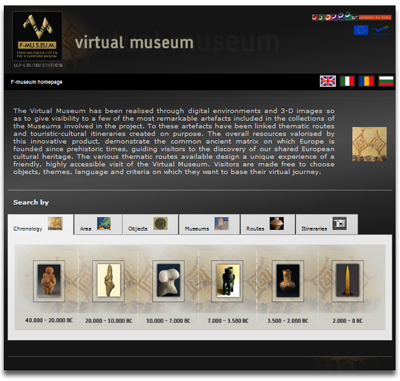 Museums from Italy, Germany, Austria, Hungary, Romania, Bulgaria and Greece have joined hands – and virtual artefacts – to create the first ‘Virtual Museum of European Roots’. They have put their most treasured objects online in 3D for visitors to explore in several thematic routes, as they are guided through European prehistoric culture and heritage. For museum professionals, there are e-courses, training them in the skills needed for establishing and managing a virtual museum.
Museums from Italy, Germany, Austria, Hungary, Romania, Bulgaria and Greece have joined hands – and virtual artefacts – to create the first ‘Virtual Museum of European Roots’. They have put their most treasured objects online in 3D for visitors to explore in several thematic routes, as they are guided through European prehistoric culture and heritage. For museum professionals, there are e-courses, training them in the skills needed for establishing and managing a virtual museum.
The ‘Berliner Goldhut‘ (Berlin Golden Hat, in the Neues Museum), thought to be a lunar and solar calendar, is part of a larger group of Golden hats and cane-shaped Bronze Age head-dresses made of a sheet of gold. Yet you are not likely to ever see them together in one exhibition. And how is Marmotta’s Venus (in Rome) related to the famous Venus from Willendorf in Vienna? The Virtual Museum of the European Roots – part of the larger F-MU.S.EU.M. (Form Multimedia System for a European Musem) project – aims to document how Europe is founded upon a common ancient matrix, consequential to the abasence of rigid boundaries and continuous migrations.
To convey this to their virtual visitors they’ve organised their collection of 3D objects – a sequence of photographs assembled in QuickTime VR – by chronology and broad themes rather than one area. If you wanted to ‘be guided’ in your discovery of our shared European cultural heritage, you may always follow their thematic routes – Civilisation; A Gift from the River; The Beginning of Metallurgy or Sport and Role Games in Prehistoric Times – which are text-based but thoroughly illustrated with photographs, 3D versions of the artefacts and video.
For museum professionals there are e-courses in Content Expert, Manager for virtual museums, Webdesigner for virtual museums (definitely read through the 3D photography part, there’s also the video to go with it, if you scroll down at europeanvirtualmuseum.net to FMUSEUM video production and choose ‘3D photo making process’) and Virtual museum communicator (which puzzles me a bit, uniform dress code for virtual museum staff but not Twitter use?)
Personally, I expected a bit more from the ‘virtual artefacts’ – only ‘horizontal spinning’ and loss of quality on zooming in seems a bit mediocre compared to our XXL King Tut Artefacts (which you can actually sit on) – but the idea behind the museum makes up for a lot of that initial disappointment. Because centralising objects in one location, so they can be linked – or tagged? – together in different storylines, regardless which collection or nation they belong to is a great aim. Maybe if Google ‘crawls’ every single museum in the world, this will eventually happen?